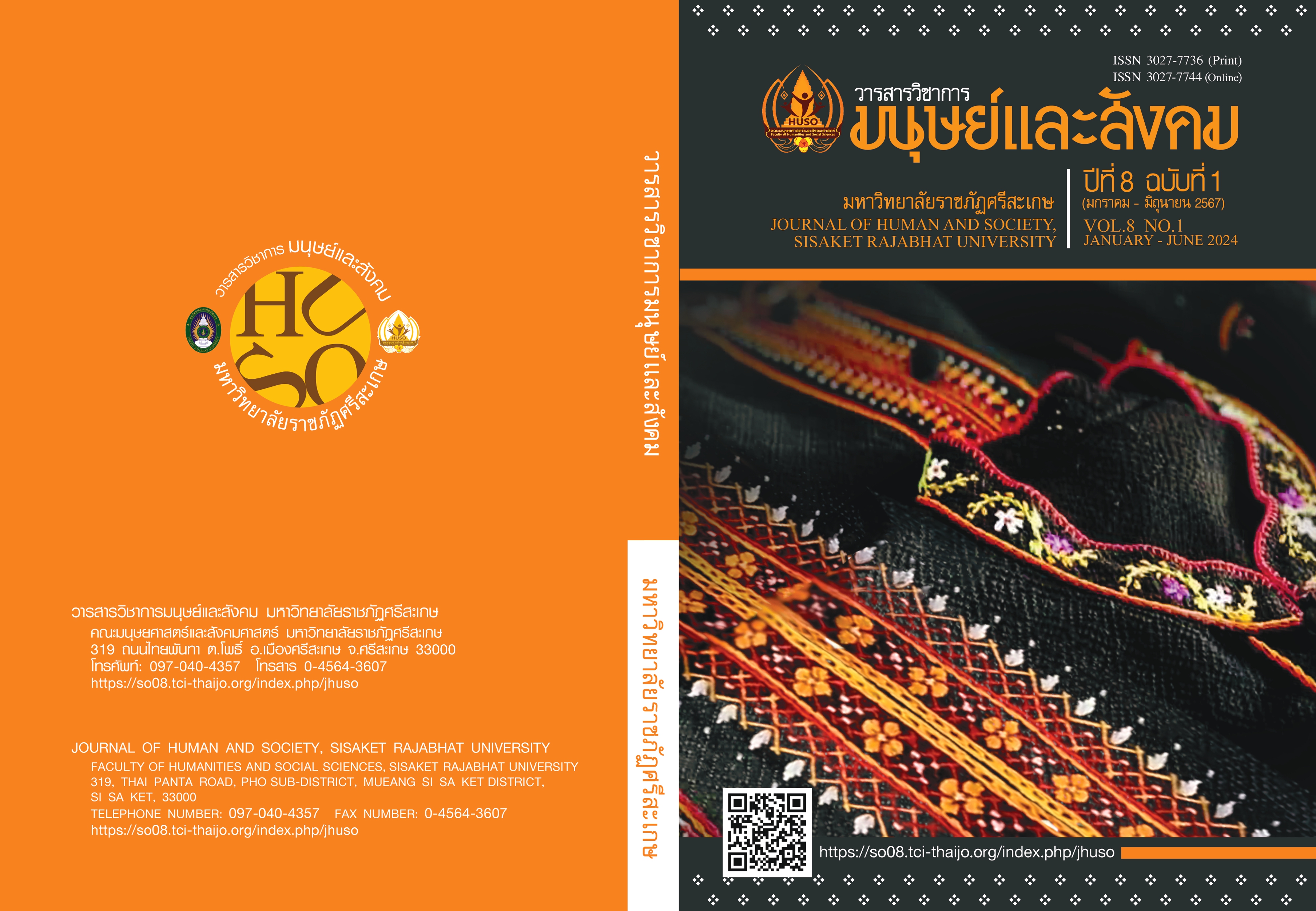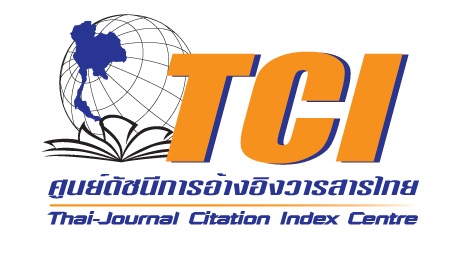Creative Design Based on the Identity of Embroidery in Si Sa Ket Province
Keywords:
CREATIVE DESIGN, IDENTITY, MBROIDERYAbstract
The study, titled “Creative Design Based on the Identity of Embroidery in Si Sa Ket” aimed to 1) explore the identity of the embroidery in Si Sa Ket and 2) develop creative designs based on the identity of the embroidery in Si Sa Ket. A mixed-method research approach, involving both documentary and on-site data collection methods, was employed. Various research tools, such as interviews, observations, focus groups, and questionnaires, were utilized to gather information from relevant people. Then, the gathered data were analyzed through a combination of design concepts, creative economy principle, identity theory, and deconstruction theory to develop creative designs based on the identity of the embroidery in Si Sa Ket.
The study discovered that the identity of the embroidery in Si Sa Ket, particularly within the Phon Kho embroidery group located in Phon Kho Sub-district, Mueang District, Si Sa Ket, is a heritage passed down through generations and necessitates continuous learning throughout the embroidery process. In the present, embroidery has transformed into a product that generates increased income and boosts economic growth within the community. The identity of the embroidery can be classified into two distinct aspects: the individual identity and the collective identity. The collective identity refers to the production techniques, designs, patterns, and colors that remain consistent with those of other groups. Regarding the patterns of the individual identity of the embroidery, it encompasses three primary patterns: the palm flower and white cheese wood pattern, the palm flower pattern, and the palm leaf pattern. In contrast, the patterns of the collective identity include ten patterns, namely the centipede’s feet pattern, the lion’s tail pattern, the chain pattern, the weaver ant’s legs pattern, the candlestick pattern, the bodhi leaf pattern, the bullet wood pattern, the Ta Laeaw sign pattern, the flower pattern, and the star-weaving pattern. These patterns can be categorized into four groups: 1) animal patterns (the centipede’s feet pattern, lion’s tail pattern, and weaver ant’s legs pattern), 2) botanic and floral patterns (the palm flower and white cheese wood pattern, palm flower pattern, palm leaf pattern, flower pattern, bodhi leaf pattern, and bullet wood pattern), 3) miscellaneous-item patterns (the Chain pattern, candlestick pattern, key pattern, and Ta Laeaw sign pattern), and 4) nature-imitating patterns (the star-weaving pattern). Data has been collected and analyzed to generate creative designs inspired by the concept of embroidery and the design concepts. This process involved analyzing consumer groups and design trends, studying trends in lifestyle products and graphic design, and extracting insights from consumers and innovative products. The result was a single collection of creative designs comprising items such as hats, bags, shoes, and scarves/shawls. This collection was subsequently subjected to evaluation by design experts, and satisfaction levels among the target groups of 50 people were assessed. The findings revealed that the scarves/shawls gained the highest level of satisfaction ( = 4.52, S.D. = 0.50), followed by the shoes (
= 4.24, S.D. = 0.50), bags (
= 4.30, S.D. = 0.52), and hats (
= 4.09, S.D. = 0.56), respectively. Overall satisfaction There is an overall average. Overall satisfaction (
= 4.29, S.D. = 0.47)
References
โครงการพัฒนาผ้าพื้นเมืองในทุกจังหวัดของประเทศ มหาวิทยาลัยศิลปากร. (2543). ผ้าทอพื้นเมืองในภาคกลาง/โครงการพัฒนาผ้าพื้นเมืองในทุกจังหวัดของประเทศ มหาวิทยาลัยศิลปากร. มหาวิทยาลัยศิลปากร.
เทิดชาย ช่วยบำรุง. (2554). ภูมิปัญญาเพื่อการพัฒนาท้องถิ่นเชิงสร้างสรรค์. สถาบันพระปกเกล้า.
ธีรพงศ์ สงผัด. (2564). การพัฒนาผลิตภัณฑ์ผ้าเก็บย้อมมะเกลือเป็น Premium OTOP และพัฒนากลุ่มสตรีทอผ้าบ้านเมืองหลวงสู่ผู้ประกอบการ Start Up. กระทรวงอุดมศึกษา.
ธีระชัย สุขสด. (2544). การออกแบบผลิตภัณฑ์อุตสาหกรรม. โอเดียนสโตร์.
บุรินทร์ เปล่งดีสกุล และภาคินี เปล่งดีสกุล. (2561). การพัฒนาผลิตภัณฑ์เชิงสร้างสรรค์จากภูมิปัญญาในการใช้ทรัพยากรในพื้นที่ชุมชนรอบเขื่อนจุฬาภรณ์ กรณีศึกษา กลุ่มวิสาหกิจชุมชนแปรรูปปลาน้ำจืด แม่สมศรี ต.ทุ่งลุยลาย อ.คอนสาร จ.ชัยภูมิ. วารสารศิลปกรรมศาสตร์ มหาวิทยาลัยขอนแก่น, 10(2), 206-230.
พนารัตน์ เดชกุลทอง. (2552). การวิจัยและพัฒนากระบวนการทอผ้าพื้นบ้านในอนุภูมิภาคลุ่มน้ำโขง : กรณีศึกษาในประเทศไทยและสาธารณรัฐประชาธิปไตยประชาชนลาว [ดุษฎีนิพนธ์ปริญญาปรัชญาดุษฎีบัณฑิต สาขาวิชายุทธศาสตร์การพัฒนาภูมิภาค]. มหาวิทยาลัยราชภัฏเลย.
สุภางค์ จันทวานิช. (2551). ทฤษฎีสังคมวิทยา (พิมพ์ครั้งที่ 4). จุฬาลงกรณ์มหาวิทยาลัย.
สำนักงานคณะกรรมการวัฒนธรรมแห่งชาติ. (2545). เอกสารประกอบการจัดสรรงบประมาณโครงการส่งเสริมสนับสนุนและพัฒนาการดำเนินงานของเครือข่ายวัฒนธรรม ประจำปีงบประมาณ 2545. ม.ป.พ.
อภิญญา เฟื่องฟูสกุล. (2546). อัตลักษณ์ การทบทวนทฤษฎีและกรอบแนวคิด. สำนักงานคณะกรรมการวิจัยแห่งชาติ.
เอกเทศ แสงลับ และพัชรา ปราชญ์เวทย์. (2558). การใช้คอมพิวเตอร์กราฟิกในการสร้างลายผ้าของกลุ่มชาติพันธุ์ในจังหวัดศรีสะเกษ. มหกรรมงานวิจัยแห่งชาติ 2559 (Thailand Research Expo 2016).
Downloads
Published
How to Cite
Issue
Section
License
Copyright (c) 2024 Journal of Human and Society, Sisaket Rajabhat University

This work is licensed under a Creative Commons Attribution-NonCommercial-NoDerivatives 4.0 International License.







